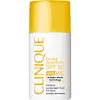What's inside
What's inside
 Key Ingredients
Key Ingredients

 Benefits
Benefits

 Concerns
Concerns

 Ingredients Side-by-side
Ingredients Side-by-side

Butyl Methoxydibenzoylmethane 3%
UV AbsorberHomosalate 10.7%
Skin ConditioningEthylhexyl Salicylate 6%
UV AbsorberBenzophenone-3 3.9%
UV AbsorberWater
Skin ConditioningCyclopentasiloxane
EmollientAlcohol Denat.
AntimicrobialSilica
AbrasiveDicaprylyl Ether
EmollientStyrene/Acrylates Copolymer
PEG-30 Dipolyhydroxystearate
EmulsifyingDimethicone
EmollientCyclohexasiloxane
EmollientPolymethylsilsesquioxane
Nylon-12
Dicaprylyl Carbonate
EmollientPhenoxyethanol
PreservativeLauryl PEG/PPG-18/18 Methicone
Skin ConditioningSodium Chloride
MaskingCaprylyl Glycol
EmollientPEG-8 Laurate
EmulsifyingPoly C10-30 Alkyl Acrylate
Emulsion StabilisingDisteardimonium Hectorite
StabilisingTocopherol
AntioxidantIsostearyl Alcohol
EmollientP-Anisic Acid
MaskingDisodium EDTA
Dodecene
MaskingPoloxamer 407
EmulsifyingButyl Methoxydibenzoylmethane 3%, Homosalate 10.7%, Ethylhexyl Salicylate 6%, Benzophenone-3 3.9%, Water, Cyclopentasiloxane, Alcohol Denat., Silica, Dicaprylyl Ether, Styrene/Acrylates Copolymer, PEG-30 Dipolyhydroxystearate, Dimethicone, Cyclohexasiloxane, Polymethylsilsesquioxane, Nylon-12, Dicaprylyl Carbonate, Phenoxyethanol, Lauryl PEG/PPG-18/18 Methicone, Sodium Chloride, Caprylyl Glycol, PEG-8 Laurate, Poly C10-30 Alkyl Acrylate, Disteardimonium Hectorite, Tocopherol, Isostearyl Alcohol, P-Anisic Acid, Disodium EDTA, Dodecene, Poloxamer 407
Titanium Dioxide 6.3%
Cosmetic ColorantZinc Oxide 4%
Cosmetic ColorantWater
Skin ConditioningDimethicone
EmollientButyloctyl Salicylate
Skin ConditioningPolydiethylsiloxane
EmollientC12-15 Alkyl Benzoate
AntimicrobialIsononyl Isononanoate
EmollientDiethylhexyl Succinate
EmollientNeopentyl Glycol Diheptanoate
EmollientMethyl Trimethicone
Skin ConditioningButylene Glycol
HumectantEthylhexyl Methoxycrylene
Skin ConditioningLauryl PEG-9 Polydimethylsiloxyethyl Dimethicone
Skin ConditioningSilica
AbrasiveDipentaerythrityl Tri-Polyhydroxystearate
EmollientLaureth-4
EmulsifyingCetyl PEG/PPG-10/1 Dimethicone
EmulsifyingDimethicone/PEG-10/15 Crosspolymer
Dimethicone Silylate
Hydrolyzed Wheat Protein/Pvp Crosspolymer
Triethoxycaprylylsilane
Dimethicone Crosspolymer-3
Skin ConditioningIsostearic Acid
CleansingCaprylyl Glycol
EmollientPolyhydroxystearic Acid
EmulsifyingDipropylene Glycol
HumectantPhenoxyethanol
PreservativeCI 77492
Cosmetic ColorantCI 77491
Cosmetic ColorantTitanium Dioxide 6.3%, Zinc Oxide 4%, Water, Dimethicone, Butyloctyl Salicylate, Polydiethylsiloxane, C12-15 Alkyl Benzoate, Isononyl Isononanoate, Diethylhexyl Succinate, Neopentyl Glycol Diheptanoate, Methyl Trimethicone, Butylene Glycol, Ethylhexyl Methoxycrylene, Lauryl PEG-9 Polydimethylsiloxyethyl Dimethicone, Silica, Dipentaerythrityl Tri-Polyhydroxystearate, Laureth-4, Cetyl PEG/PPG-10/1 Dimethicone, Dimethicone/PEG-10/15 Crosspolymer, Dimethicone Silylate, Hydrolyzed Wheat Protein/Pvp Crosspolymer, Triethoxycaprylylsilane, Dimethicone Crosspolymer-3, Isostearic Acid, Caprylyl Glycol, Polyhydroxystearic Acid, Dipropylene Glycol, Phenoxyethanol, CI 77492, CI 77491
 Reviews
Reviews

Ingredients Explained
These ingredients are found in both products.
Ingredients higher up in an ingredient list are typically present in a larger amount.
Caprylyl Glycol is a humectant and emollient, meaning it attracts and preserves moisture.
It is a common ingredient in many products, especially those designed to hydrate skin. The primary benefits are retaining moisture, skin softening, and promoting a healthy skin barrier.
Though Caprylyl Glycol is an alcohol derived from fatty acids, it is not the kind that can dry out skin.
This ingredient is also used as a preservative to extend the life of products. It has slight antimicrobial properties.
Learn more about Caprylyl GlycolDimethicone is a type of synthetic silicone created from natural materials such as quartz.
What it does:
Dimethicone comes in different viscosities:
Depending on the viscosity, dimethicone has different properties.
Ingredients lists don't always show which type is used, so we recommend reaching out to the brand if you have questions about the viscosity.
This ingredient is unlikely to cause irritation because it does not get absorbed into skin. However, people with silicone allergies should be careful about using this ingredient.
Note: Dimethicone may contribute to pilling. This is because it is not oil or water soluble, so pilling may occur when layered with products. When mixed with heavy oils in a formula, the outcome is also quite greasy.
Learn more about DimethiconePhenoxyethanol is a preservative that has germicide, antimicrobial, and aromatic properties. Studies show that phenoxyethanol can prevent microbial growth. By itself, it has a scent that is similar to that of a rose.
It's often used in formulations along with Caprylyl Glycol to preserve the shelf life of products.
Silica, also known as silicon dioxide, is a naturally occurring mineral. It is used as a fine, spherical, and porous powder in cosmetics.
Though it has exfoliant properties, the function of silica varies depending on the product.
The unique structure of silica enhances the spreadability and adds smoothness, making it a great texture enhancer.
It is also used as an active carrier, emulsifier, and mattifier due to its ability to absorb excess oil.
In some products, tiny microneedles called spicules are made from silica or hydrolyzed sponge. When you rub them in, they lightly polish away dead skin layers and enhance the penetration of active ingredients.
Learn more about SilicaWater. It's the most common cosmetic ingredient of all. You'll usually see it at the top of ingredient lists, meaning that it makes up the largest part of the product.
So why is it so popular? Water most often acts as a solvent - this means that it helps dissolve other ingredients into the formulation.
You'll also recognize water as that liquid we all need to stay alive. If you see this, drink a glass of water. Stay hydrated!
Learn more about Water